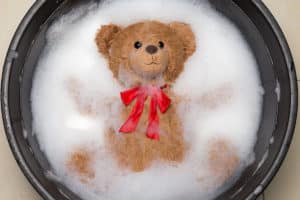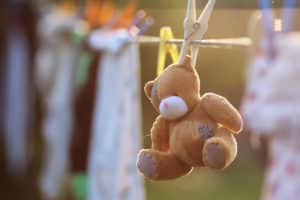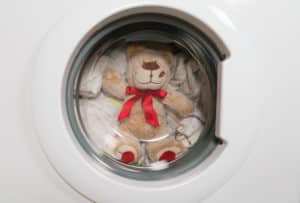Whether you’re a die-hard teddy bear lover or a parent who wants to reuse the family bear, one question is bound to be familiar to you: how do you clean an old teddy bear without damaging it? Indeed, washing a teddy bear whose stuffing is hanging on by a thread seems to be an extremely risky operation. However, you want to give it a new lease on life, whether it has been with you all your life or was the first one to come out of the Steiff factory. This is precisely what we will talk about in this article. We’ll list several methods, detailing each step so you can properly clean your antique bear .
Dry cleaning methods
We start with the least invasive (yet fastest) methods of how to clean an antique teddy bear. On the other hand, they won’t get rid of the most stubborn stains.
Baking soda
Often seen as the ultimate grandmother’s trick, baking soda is very useful here to remove greasy stains while deodorizing the teddy bear. Follow the guide.
- Sprinkle on the old teddy bear. Don’t be afraid to go all out and wrap it completely, especially in the stained areas.
- Let the teddy bear sit in a cloth bag. A few hours will do, remembering to stir it from time to time.
- Take it out of the bag and dust your teddy bear with a cloth or brush . One of the attractions of baking soda is that it is food safe, meaning that even if there is a little bit left in the hair of your old bear, it is safe.
Starch, a gift for your friend
Very useful when trying to clean delicate fabrics, it is possible to make your own with potatoes or cornstarch, we’ll let you look. Then follow these steps.
- Depending on its condition, slightly moisten your starch if it is in powder form and then apply it directly to the stains of your old bear, with a sprayer if the starch is liquid or by rubbing as a paste.
- Leave your bear in the open air until the starch dries.
- Once dry, remove the starch by scraping or gently rubbing.
Quarantine
As a last resort for very old bears that can no longer tolerate human contact, you can at least rid them of mites before putting them in your collection.
- Put your old bear in a plastic bag. You can add mothballs, in which case you can stop at this point, remembering to take it out of the bag after 14 days.
- Place the bag (with your bear) in a freezer for 48 hours.
- Take the bear out of the bag and let it thaw at a low temperature (like in a refrigerator).
Water washing methods
These methods take longer than dry cleaning methods and are not recommended for teddy bears that have been damaged by time. However, they are also much more effective.
Spot washing
This method uses the least amount of water of all the methods we offer. It will also require the most effort.
If you have a Marseille soap
- We assume that you have a 100% Marseille soap. Moisten a corner of it and gently apply it on the stain(s) of your old stuffed animal so as not to damage it.
- Once the soap is applied, rub the stain until it is gone. This part can be long and difficult. Don’t hesitate to come back to it several times if you need to.
- Clean up any remaining soap scum with a suitable cloth, such as a moistened washcloth.
If you don’t have one
You will still need a detergent.
- Dampen the affected area(s) of your teddy bear. If there is too much, use the following method.
- Apply your detergent sparingly to the wet areas. The goal here is not to make too much foam so that you can rinse it off properly afterwards.
- For the rest, follow the last steps of the previous method.
The big bath
When using this method, make sure that your old teddy bear does not absorb too much water, which could damage it.
- Prepare your bear and his bath. Remove the various clothes and accessories he has (if possible) and prepare a large container of warm water into which you will pour a few drops of soap.
- Dip your bear in the water and wash him. The trick here is not to submerge your stuffed animal completely, but only one dirty part at a time. This way, the bear won’t absorb too much water at once. To remove the stains, we will do exactly the same as the method with Marseille soap. However, this will require much less effort.
- Rinse your stuffed animal so that the soap is completely removed. As in the previous step, it is advisable to rinse part by part.
Once washed, it’s time to dry your bear
These are the last steps of each of the previous methods. We have separated them so that we do not have to repeat ourselves.
Spinning
This step requires you to be extremely gentle with the plush. You will need to squeeze each part of the bear thoroughly to get as much water out of it as possible while keeping its original shape. Once this is done, dab the excess moisture from his fur with a towel. You will save a lot of time on drying by doing this, so we recommend it.
However, be careful not to give in to certain automatisms: twisting your teddy bear around like you would a tea towel will only damage it further.
Drying
Air-drying your teddy bear, lying flat in a warm, dry place, is the solution we recommend most. It is obviously the slowest, but it is the most likely to return your teddy bear to you in the condition you want. However, if the lint is not too damaged, it is possible to use a hair dryer if you are short on time. Be sure to use the least hot option and keep it more than a foot away from its fur.
Brushing
You’re almost there, so don’t neglect this last step. Not only does it give your old bear a little shine, but it also allows you to detect hard parts of its fur, indicating that you have not completely removed the soap from that area. You’ll just have to rinse your bear again.
Things NOT to do
Machine wash your bear
We’re talking about heavily used bears that no longer have the elasticity of yesteryear, or older bears that weren’t created with this option in mind. This also applies to the dryer.
Dusting it with a vacuum cleaner
This is the best way to further fray your teddy bear. However, you can try this with newer (and stronger) stuffed animals if you feel like it.
You now have a brand new antique bear
We hope that we have been able to help give a second life to some of your old bears. Don’t hesitate to let us know in comments, we would be very happy. Also, if you know of any other methods to clean old teddy bears, we look forward to hearing from you in comments so we can share it with everyone. Long live teddy bears!



